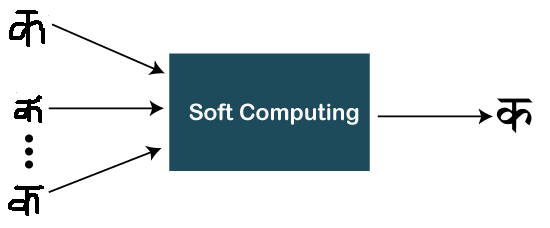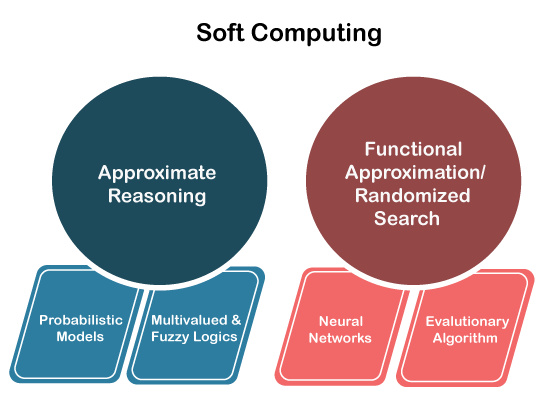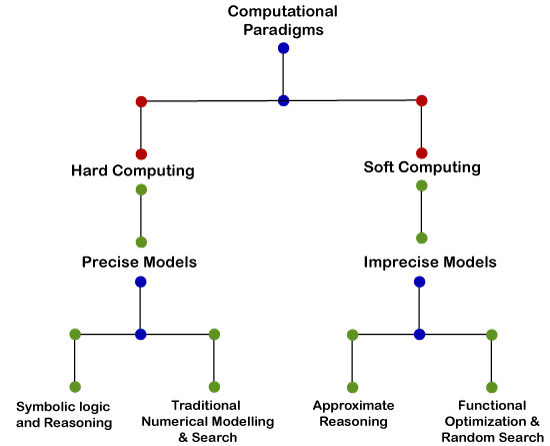What is soft computingSoft computing is the reverse of hard (conventional) computing. It refers to a group of computational techniques that are based on artificial intelligence (AI) and natural selection. It provides cost-effective solutions to the complex real-life problems for which hard computing solution does not exist. Zadeh coined the term of soft computing in 1992. The objective of soft computing is to provide precise approximation and quick solutions for complex real-life problems. 
In simple terms, you can understand soft computing - an emerging approach that gives the amazing ability of the human mind. It can map a human mind and the human mind is a role model for soft computing. Note: Basically, soft computing is different from traditional/conventional computing and it deals with approximation models.Some characteristics of Soft computing
ExampleSoft computing deals with the approximation model. Yoi will understand with the help of examples of how it deals with the approximation model. Let's consider a problem that actually does not have any solution via traditional computing, but soft computing gives the approximate solution. string1 = "xyz" and string2 = "xyw" Let's modify the problem a bit. You have noticed that soft computing gave us the approximate solution. Applications of soft computingThere are several applications of soft computing where it is used. Some of them are listed below:
As we already said that, soft computing provides the solution to real-time problems and here you can see that. Besides these applications, there are many other applications of soft computing. Need of soft computingSometimes, conventional computing or analytical models does not provide a solution to some real-world problems. In that case, we require other technique like soft computing to obtain an approximate solution.
Elements of soft computingSoft computing is viewed as a foundation component for an emerging field of conceptual intelligence. Fuzzy Logic (FL), Machine Learning (ML), Neural Network (NN), Probabilistic Reasoning (PR), and Evolutionary Computation (EC) are the supplements of soft computing. Also, these are techniques used by soft computing to resolve any complex problem. 
Any problems can be resolved effectively using these components. Following are three types of techniques used by soft computing:
Fuzzy Logic (FL)Fuzzy logic is nothing but mathematical logic which tries to solve problems with an open and imprecise spectrum of data. It makes it easy to obtain an array of precise conclusions. Fuzzy logic is basically designed to achieve the best possible solution to complex problems from all the available information and input data. Fuzzy logics are considered as the best solution finders. Neural Network (ANN)Neural networks were developed in the 1950s, which helped soft computing to solve real-world problems, which a computer cannot do itself. We all know that a human brain can easily describe real-world conditions, but a computer cannot. An artificial neural network (ANN) emulates a network of neurons that makes a human brain (means a machine that can think like a human mind). Thereby the computer or a machine can learn things so that they can take decisions like the human brain. Artificial Neural Networks (ANN) are mutually connected with brain cells and created using regular computing programming. It is like as the human neural system. Genetic Algorithms (GA)Genetic algorithm is almost based on nature and take all inspirations from it. There is no genetic algorithm that is based on search-based algorithms, which find its roots in natural selection and the concept of genetics. In addition, a genetic algorithm is a subset of a large branch of computation. Soft computing vs hard computingHard computing uses existing mathematical algorithms to solve certain problems. It provides a precise and exact solution of the problem. Any numerical problem is an example of hard computing. On the other hand, soft computing is a different approach than hard computing. In soft computing, we compute solutions to the existing complex problems. The result calculated or provided by soft computing are also not precise. They are imprecise and fuzzy in nature. 
Next TopicTypes of Angles
|
 For Videos Join Our Youtube Channel: Join Now
For Videos Join Our Youtube Channel: Join Now
Feedback
- Send your Feedback to [email protected]
Help Others, Please Share










